Zotac GeForce GT 640 DDR3 Review: Glacial Gaming & Heavenly HTPC
by Ryan Smith & Ganesh T S on June 20, 2012 12:00 PM ESTPower, Temperature, & Noise
As always, we wrap up our look at a new video card with a look at the physical performance attributes: power consumption, temperatures, and noise. NVIDIA is breaking new ground for desktop Kepler with their first sub-75W card, so it will be interesting to see just what the tradeoff is for such low power consumption.
| Zotac GeForce GT 640 DDR3 Voltages | |||
| GT 640 Idle | GT 640 Load | ||
| 0.95v | 1.00v | ||
NVIDIA doesn’t do a lot of voltage scaling with the GT 640. At idle it runs at 0.95v, and makes a short jump to 1.00v under full load. For a 28nm GPU 0.95v under idle is a bit higher than what we’ve seen in the past, which may explain the official 15W idle TDP.
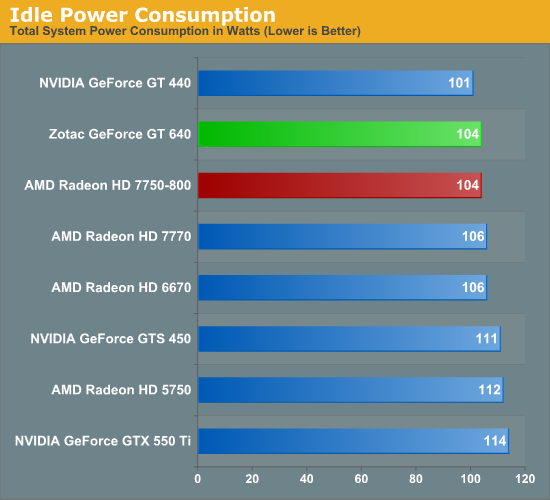
Earlier we theorized that the GT 640 would have worse idle power characteristics than the GT 440, and this appears to be the case. The difference at the wall is all of 3W but it’s a solid indication that NVIDIA has at best not improved on their idle power consumption, if not made it a bit worse. The good news for them is that in spite of this slight rise in idle power consumption it’s still enough to tie the 7750 and beat older cards like the 6670 and GTS 450.
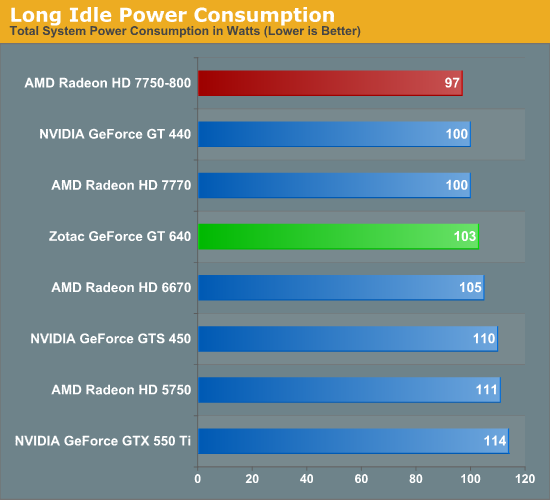
Long idle on the other hand sees the 7750 jump back into the lead, as NVIDIA doesn’t have anything resembling AMD’s ZeroCore power technology.
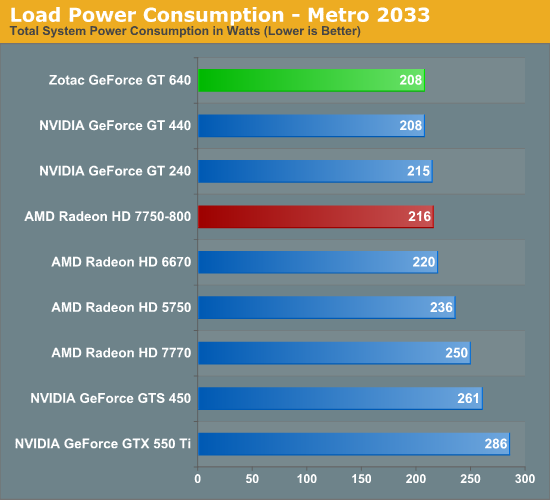
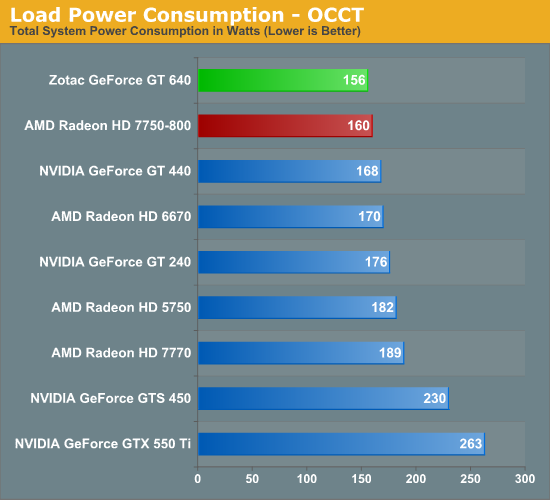
Of all of the sub-75W cards in our benchmark suite, the GT 640 ends up having the lowest load power consumption. Under both Metro and OCCT it’s equal to or better than the GT 440, GT 240, 6670, and 7750. AMD’s official PowerTune limit on the latter is 75W versus the GT 640’s 65W TDP, so this is not unexpected, but it’s always nice to have it confirmed in numbers. That said, for desktop usage I’m not sure 4-8W at the wall is all that big of a deal. So while NVIDIA’s power consumption is marginally lower than the 7750 they aren’t necessarily gaining anything tangible from it, particularly when you consider the loss in performance.

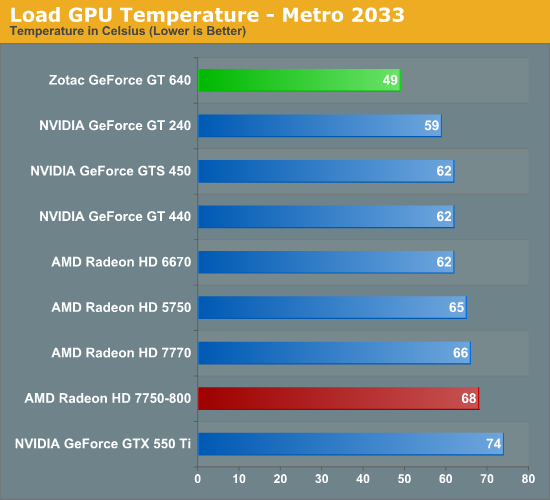
GPU temperatures look absolutely stunning here, and in fact it’s better than we would have expected. Zotac’s heatsink is not particularly large, and while these type of cards typically stay under 70C we would not have expected a single-slot heatsink to perform this well. If these kinds of temperatures can carry over into other designs there’s a very good chance we’re going to see some nice passively cooled cards in the near future. In the meantime buyers sheepish about high temperatures are going to find that Zotac’s GT 640 is an exceptional card.
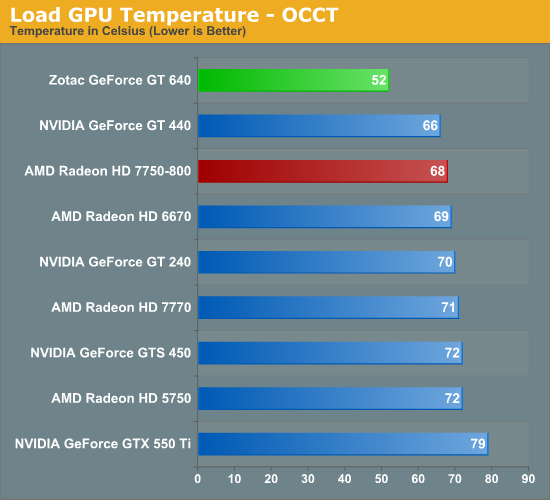

Last but not least we have noise. Zotac’s card may be exceptionally cool, but that single slot cooler and small fan comes back to bite them when it comes to noise. That little fan simply doesn’t idle well, leading to the Zotac GT 640 being one of the loudest idling sub-75W card we’ve seen in quite some time. Zotac fares much better under load – where the 7750’s equally tiny and tinny fan leads to the 7750 ending up as the louder card by about 1dB – but really neither of these cards is particularly quiet for as little power as they consume. HTPC users who aren’t already looking at passively cooled cards are probably going to want to look elsewhere unless they absolutely need a single-slot card, as there’s a very clear tradeoff on size versus noise here.










60 Comments
View All Comments
extide - Wednesday, June 20, 2012 - link
For posting folding benchmarks! A lot of people really appreciate that!Zink - Wednesday, June 20, 2012 - link
+1No one else uses your benchmarking tool and it doesn't always correlate to performance with current F@H projects but that is the only reason I care about GPUs.
Marlin1975 - Wednesday, June 20, 2012 - link
Good design if it had DDR5. If they can do 2gig of DDR5 then it be a great mid-price card.Homeles - Wednesday, June 20, 2012 - link
It would still be terrible until the price dropped.Samus - Thursday, June 21, 2012 - link
There's no reason this wouldn't be similar in speed to a GTX460 if it had DDR5. The only difference would be 128-bit vs 192-bit memory bus, everything else would be an advantage: same number cores, substantially higher clock speed, lower power consumption increasing overclocking headroom, etc.MrSpadge - Thursday, June 21, 2012 - link
You forget: substantially lower shader clock speed, more coarse shader grouping -> more difficult to use them all at once, and software scheduling -> need a better compiler, can't do runtime optimizations.t_case - Wednesday, June 20, 2012 - link
So who has the Sony VPL-vw1000ES? Now that's a nice projector... only roughly the price of a new car heh.stephenasmith - Wednesday, June 20, 2012 - link
I love me some painfully slow gaming!nitrousoxide - Wednesday, June 20, 2012 - link
Just curious if the most powerful IGP can keep up with entry-level KeplerRoland00Address - Wednesday, June 20, 2012 - link
But this should get you an idea of what performance you would be getting with llano. (Numbers taken from Llano review that appeared 12 months ago so drivers will be old.)Crysis Warhead 1680x1050 performance quality
A8-6550D with 1600 mhz memory
58.8 fps
A8-6550D with 1866 mhz memory
62.5 fps
GT640
99.8 fps
This makes the 640 about 69.7% faster than a non overclock Llano (people are going to get 1600mhz memory).